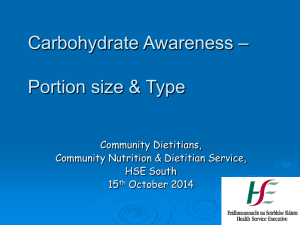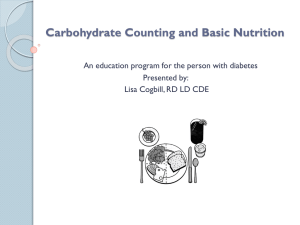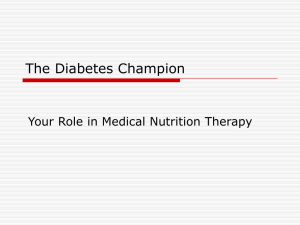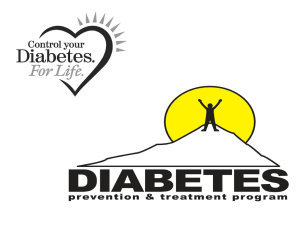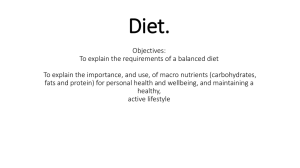Click here to see the Document
advertisement
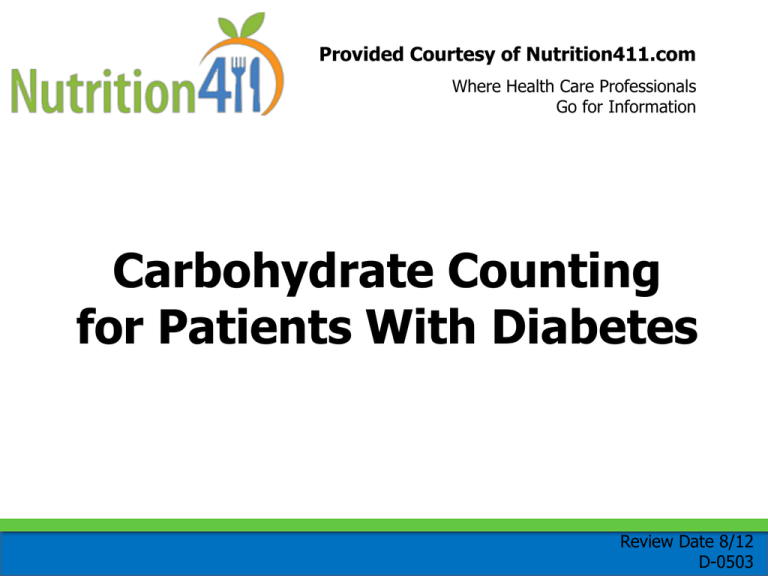
Provided Courtesy of Nutrition411.com Where Health Care Professionals Go for Information Carbohydrate Counting for Patients With Diabetes Review Date 8/12 D-0503 Program Purpose • To increase knowledge of carbohydrate-counting skills for those caring for patients with diabetes • All health professionals should have a sound knowledge base of carbohydrate counting—a skill needed by all health care professionals caring for patients with diabetes Program Objectives At the end of the session you will know how to: • Define carbohydrate counting • Identify the relationship between carbohydrates and blood sugar • Determine the grams of carbohydrate in foods when using the nutritional food label and other carbohydrate-counting tools • Calculate the total grams of carbohydrate/meal Carbohydrate (CHO) Counting Defined • A meal-planning approach for all patients with diabetes, based on the following ideas: – Carbohydrate is the main nutrient affecting postprandial glycemic response – Total amount of carbohydrates consumed is more important than the source of carbohydrates Benefits of Carbohydrate Counting • More flexible than other meal-planning methods • Sugar is not forbidden • Attention is focused on the foods that are most likely to make blood glucose levels go up Foods That Contain Carbohydrates • Breads, cereals, pasta, and grains • Rice, beans, and starchy vegetables (potatoes, corn, and peas) • Fruit and fruit juices • Milk and yogurt • Regular soda, fruit drinks, jelly beans, and gumdrops • Cakes, cookies, and candy Grams of Carbohydrate (per food category) • Starch and fruit: 1 serving equals about 15 grams (g) carbohydrate • Milk: 1 serving equals about 12 g carbohydrate • Vegetables: 1 serving equals about 5 g carbohydrate Starches Starch Group Each amount listed below=15 g carbohydrate 1 ounce (oz) of bagel, bread, or roll (1 slice of bread or one fourth of a bagel) ¾ cup (C) unsweetened cereal (Cheerios®, Rice Krispies®, or cornflakes) ⅓ C higher carbohydrate cereals (raisin bran) One half of an English muffin ⅓ C cooked pasta, spaghetti, or macaroni and cheese ⅓ C cooked brown or white rice ½ C mashed potatoes ½ C corn, beans, chickpeas, or peas 1 small baked potato (3 oz) Fruit and Fruit Juices Fruit Group Each amount listed below=15 g carbohydrate 1 small fresh fruit (4 oz) ½ C canned fruit (in natural juice) 2 tablespoons (Tbsp) raisins 17 grapes ½ C fruit juice 1 C fresh fruit (cut up) Milk and Yogurt Milk Group Each amount listed below=approximately 12 g carbohydrate 8 fluid ounces (fl oz) of skim, 1%, 2%, or whole milk 1 C plain yogurt 1 C plain or vanilla soy milk Vegetables Vegetables Vegetables are counted as 5 g carbohydrate for the following servings sizes: • ½ C cooked vegetables • 1 C raw vegetables Foods Without Carbohydrate Protein and fat groups contain 0 g carbohydrate Examples: • Protein: Meat, fish, poultry, cheese, eggs, peanut butter, cottage cheese, and tofu • Fat: Butter, oils, margarine, mayonnaise, cream cheese, sour cream, nuts, seeds, avocados, and salad dressings Carbohydrate and Noncarbohydrate Categories Groups/Lists CHO Protein Fat Calories Starch 15 3 ≤1 80 Fruit 15 0 0 60 Milk: Skim Low fat Whole 12 12 12 8 8 8 0–3 5 8 90 120 150 Other carbohydrates 12 varies varies varies Vegetables 5 2 0 25 0 0 0 0 7 7 7 7 0–1 3 5 8 35 55 75 100 0 0 5 45 Meat and substitute group: Very lean Lean Medium fat High fat Fat group Relationship Between Carbohydrate and Blood Sugar • The digestive system converts most digestible carbohydrates into glucose (also known as blood sugar) • Cells are designed to use this as a universal energy source • As blood sugar levels rise in an individual who does not have diabetes, beta cells in the pancreas churn out more and more insulin, a hormone that signals cells to absorb blood sugar for energy or storage Carbohydrate and Blood Sugar in Diabetes • Individuals with type 1 diabetes—the pancreas does not make any insulin, so their cells cannot absorb sugar • Individuals with type 2 diabetes—the pancreas does not make enough insulin or the insulin is not effective, because the cells are insulin resistant • Carbohydrates begin to raise blood glucose within approximately 5 minutes after initiation of food intake • Carbohydrates are converted to nearly 100% blood glucose within about 2 hours Carbohydrate and Blood Sugar in Diabetes (cont’d) • The focus of carbohydrate counting is on the one nutrient that most impacts blood glucose • Carbohydrate is the primary nutrient affecting blood glucose levels • Individuals can learn to relate carbohydrate intake with their blood glucose results Carbohydrate and Blood Sugar in Diabetes (cont’d) • All patients with diabetes should test their blood glucose before and 2 hours after the first bite of a meal • This is the only way to tell how the choices and amount of carbohydrates consumed affect their blood sugar Blood Sugar Target Ranges • Fasting/before meals: 90–130 milligrams (mg)/deciliter (dL) • After meals (2 hours after first bite): <180 mg/dL or 30–50 mg/dL increase from premeal to postmeal Carbohydrate and Blood Sugar in Diabetes—Example • Mr. S consumed 90 g of carbohydrate for breakfast (day 1): – Blood sugar premeal=115 mg/dL – Blood sugar postmeal=205 mg/dL • Mr. S consumed 45 g of carbohydrate for breakfast (day 2) – Blood sugar premeal=125 mg/dL – Blood sugar postmeal=150 mg/dL Carbohydrate Substituting • When carbohydrate counting, it is possible to substitute one food item for another for a similar impact on blood glucose • Example: Exchange one small apple (4 oz) for two small cookies for a similar effect on blood glucose Food Labels Total carbohydrate— includes grams of sugar, sugar alcohol, starch, and dietary fiber Total grams of carbohydrate—to determine amount of carbohydrate eaten, multiply grams of total carbohydrates on the label by the number of servings eaten Food Labels • Example: You just ate 10 crackers (from the previous label) • There are two crackers/serving • How many servings did you eat? – Five servings • How many total carbohydrates did you consume? – 10 g/serving x 5 servings=50 g Tools for Carbohydrate Counting Nutrition Labels Measuring Tools Carbohydrate Counting Hand Guide Carbohydrate Allowances for Meals and Snacks • Patients with diabetes should work with a registered dietitian or certified diabetes educator to receive an individualized meal plan, which includes how many total carbohydrates to consume at meals and snacks • A general guideline for patients is 45–60 g/meal and 15–30 g/snack Sample Menu Breakfast How many carbohydrates are in this meal? 1½ C of Cheerios=? Small banana (4 oz)=? 8-fl-oz 1% milk=? 1 egg=? Sample Menu Breakfast Answers 1½ C Cheerios=30 g Small banana (4 oz)=15 g 8-fl-oz 1% milk=12 g 1 egg=0 g TOTAL= 57 g Sample Menu Lunch How many carbohydrates are in this meal? 2 slices of bread=? 17 grapes=? 1 C raw carrots=? 3 oz tuna fish=? 1 tsp mayonnaise=? Sample Menu Lunch Answers: 2 slices of bread=30 g 17 grapes=15 g 1 C raw carrots=5 g 3 oz tuna fish=0 g 1 tsp mayonnaise=0 g TOTAL= 50 g Sample Menu Dinner How many carbohydrates are in this meal? 1½ C pasta=? 1 oz of bread=? 1 C salad =? 1 tsp olive oil=? Sample Menu Dinner Answers: 1½ C pasta=68 g 1 oz of bread=15 g 1 C salad =5 g 1 tsp olive oil= 0 g TOTAL=88 g Conclusions • Carbohydrate counting is a meal-planning approach to help people with diabetes attain and maintain blood sugar control • Carbohydrate counting provides flexibility and helps people increase their confidence in managing their diabetes • Patients should consult a registered dietitian or certified diabetes educator to help them master their carbohydrate-counting skills References • American Diabetes Association. Standards of Medical Care in Diabetes. Diabetes Care. 2007;30:S4-S41. • American Dietetic Association, American Diabetes Association. Exchange Lists for Meal Planning. Chicago, IL, Alexandria, VA: American Dietetic Association, American Diabetes Association; 2003. • Thomas E. Survey reveals shortfall in pediatric nurses' knowledge of diabetes. J Diabetes Nurs. 2004;8:217-221. • Warshaw H, Bolderman K. Practical Carbohydrate Counting: A How to Teach Guide for Health Professionals. Alexandria, VA: American Diabetes Association; 2001. • Warshaw H, Kulkarni K. American Diabetes Association Complete Guide to Carbohydrate Counting. Alexandria, VA: American Diabetes Association; 2004. Provided Courtesy of Nutrition411.com Where Health Care Professionals Go for Information Thank You! Questions?
